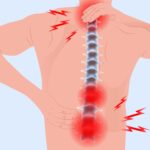What exactly is a herniated disc and what are the methods used to treat it?
A herniated disc is a common medical condition that affects millions of people worldwide. It occurs when the soft, gel-like center of a spinal disc pushes through a weak area in the tough outer layer of the disc, causing it to bulge or rupture. This can result in pain, numbness, tingling, and weakness in the affected area of the body. In this article, we will discuss the causes, symptoms, and treatment options for a herniated disc.
Anatomy of a Spinal Disc
Prior knowledge of the anatomy of a spinal disc is crucial in comprehending the definition of a herniated disc. A spinal disc is a round, flat structure that sits between each pair of vertebrae in the spine. It acts as a cushion and shock absorber, allowing for movement and flexibility in the spine. The spinal disc is composed of two components: the annulus fibrosus, which is a durable, outer layer, and the nucleus pulposus, which is a soft, gelatinous center.
Causes of a Herniated Disc
A herniated disc can occur for several reasons, including:
Age-related wear and tear
With increasing age, the water content in the spinal discs diminishes, leading to reduced flexibility and heightened vulnerability to damage.
Trauma
A sudden, forceful movement can cause the annulus fibrosus to tear, allowing the nucleus pulposus to leak out.
Repetitive strain
Repeated bending, twisting, and lifting can put pressure on the spinal discs, causing them to weaken over time.
Symptoms of a Herniated Disc
The indications of a herniated disc may differ based on the extent and position of the trauma. Some common symptoms include:
Back or neck pain
Pain in the back or neck is the most common symptom of a herniated disc.
Radiating pain
The pain may radiate down the arm or leg, depending on which disc is affected.
Numbness or tingling
Numbness or tingling can be experienced in the affected region due to a herniated disc.
Weakness
Weakness in the muscles of the affected area may also occur.
Diagnosis of a Herniated Disc
A herniated disc is usually diagnosed through a physical exam and imaging tests, such as an X-ray, MRI, or CT scan.
Treatment Options for a Herniated Disc
There are several treatment options for a herniated disc, including:
Rest and Physical Therapy
Resting the affected area and performing specific exercises can help relieve pain and improve mobility.
Medications
Pain-relieving medications, such as nonsteroidal anti-inflammatory drugs (NSAIDs) and muscle relaxants, may be prescribed to alleviate pain and inflammation.
Injections
Corticosteroid injections can reduce inflammation and relieve pain in the affected area.
Surgery
Surgery may be necessary in severe cases where other treatment options have failed to relieve symptoms.
Preventing a Herniated Disc
Though not all instances of a herniated disc can be averted, there exist numerous measures one can take to lower their vulnerability, including:
Maintaining good posture
Maintaining proper posture when sitting, standing, and lifting can help reduce the risk of injury.
Regular exercise
Incorporating regular exercise into one’s routine can aid in fortifying the muscles that uphold the spine, thereby diminishing the possibility of harm.
Avoiding heavy lifting
Avoiding heavy lifting and repetitive bending and twisting can help prevent injury to the spinal discs.
Conclusion
A herniated disc is a common medical condition that can cause significant pain and discomfort. While treatment options are available, prevention is the best course of action. By maintaining good posture, regular exercise, and avoiding heavy lifting, you can reduce your risk of developing a herniated disc. If you do experience symptoms, seeking medical attention and following the appropriate treatment plan can help relieve pain and improve your quality of life.
FAQs
- Can a herniated disc heal on its own?
Answer: In some cases, a herniated disc can heal on its own with rest and physical therapy. Nonetheless, in instances of heightened severity, medical involvement might become imperative.
- Can a herniated disc be prevented?
Answer: While it may not be possible to prevent all cases of a herniated disc, there are steps you can take to reduce your risk, such as maintaining good posture, regular exercise, and avoiding heavy lifting.
- What is the expected recovery duration for a herniated disc?
Answer: Recovery time can vary depending on the severity of the herniated disc and the treatment plan. The recovery period for a herniated disc may vary, with some individuals recuperating within a few weeks and others requiring several months.
- Can a herniated disc cause permanent damage?
Answer: In some cases, a herniated disc can cause permanent nerve damage if left untreated. Seeking medical attention early can help prevent this from happening.
- What is the most effective treatment for a herniated disc?
Answer: The most effective treatment for a herniated disc depends on the severity of the injury. Rest and physical therapy, medications, injections, and surgery are all potential treatment options. It is advisable to seek advice from a medical expert to identify the most suitable plan of action for your individual situation.



